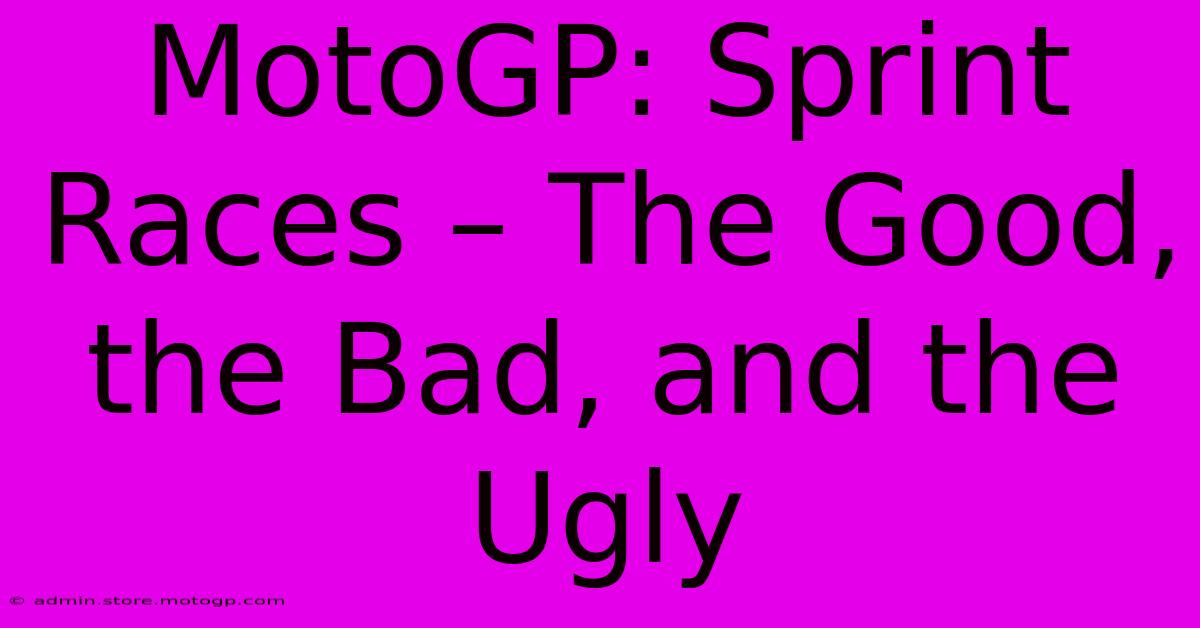MotoGP: Sprint Races – The Good, The Bad, And The Ugly

Table of Contents
MotoGP: Sprint Races – The Good, the Bad, and the Ugly
MotoGP's introduction of sprint races in 2023 has been a controversial topic, sparking passionate debate among fans and pundits alike. While designed to inject more excitement and increase weekend viewing figures, the impact of these shorter races has been multifaceted, presenting both advantages and disadvantages. Let's delve into the good, the bad, and the ugly aspects of MotoGP's sprint race experiment.
The Good: Increased Excitement and Action
One undeniable benefit of sprint races is the heightened level of excitement they bring. The shorter format, typically around half the distance of a main race, encourages more aggressive riding and risk-taking. Riders have less to lose, leading to more overtaking maneuvers and thrilling battles for position. This increased on-track action translates to more engaging viewing experiences for fans, keeping them glued to their screens from lights out to the checkered flag. The intensity is palpable, making every lap count.
More Opportunities for Points and Championship Implications
The introduction of sprint races has also significantly impacted the championship standings. With additional points on offer, every session now holds crucial weight. A strong performance in the sprint can provide a crucial advantage heading into the main race, shaping strategies and influencing the overall championship battle. This makes the entire weekend more unpredictable and adds another layer of strategic depth to the competition. A win in the sprint race isn't just a victory, it's a statement of intent.
The Bad: Physical and Mental Strain on Riders and Teams
The increased intensity and frequency of racing have, however, taken their toll. Riders are now facing a significantly heavier workload, increasing the physical and mental strain on both athletes and their teams. The added demands can lead to fatigue, potentially increasing the risk of crashes and injuries. The logistical challenges of preparing for and recovering between races are also amplified, impacting the efficiency and overall strategy of the team. The pressure is undeniably higher, pushing everyone to their limits.
Diluting the Main Race Significance?
A common criticism is that sprint races might be inadvertently diluting the importance of the main Grand Prix. With a significant points haul already secured on Saturday, the Sunday race might feel less crucial, potentially impacting the level of competition and reducing the overall drama. Some argue that the traditional format, with one main race, offered a more focused and significant showdown, creating a more pronounced sense of occasion and anticipation. The question remains: are two races better than one?
The Ugly: Tire Degradation and Strategy Complications
The shorter sprint races have also introduced new strategic considerations, particularly concerning tire management. The aggressive riding style often employed in sprints can lead to increased tire wear, potentially impacting performance in the main race. Teams must carefully balance the need for a strong sprint result with the need to preserve tires for the longer race on Sunday. This adds another layer of complexity, making strategic decisions even more critical and challenging. Finding the perfect balance between sprint performance and main race endurance is a delicate act.
Conclusion: A Work in Progress
MotoGP's sprint races represent a bold experiment with both positive and negative consequences. While undeniably increasing the excitement and offering more opportunities for points, concerns about rider fatigue, the impact on the main race's significance, and tire management remain. Whether this new format ultimately proves successful remains to be seen. Further adjustments and analysis are crucial to determine if the benefits outweigh the drawbacks and if it continues to evolve into a sustainable and engaging addition to the MotoGP calendar. Only time will tell the true impact of this significant change.

Thank you for visiting our website wich cover about MotoGP: Sprint Races – The Good, The Bad, And The Ugly. We hope the information provided has been useful to you. Feel free to contact us if you have any questions or need further assistance. See you next time and dont miss to bookmark.
Featured Posts
-
The Ultimate Cota F1 General Admission Checklist
Feb 18, 2025
-
Moto Gp Arcade Game Experience The Real Deal
Feb 18, 2025
-
The Ultimate Riding Companion Replica Motorcycle Helmets
Feb 18, 2025
-
Lub Si Cota Creating A Life Of Abundance
Feb 18, 2025
-
Aerodynamics Redefined The Sting In F1 Design
Feb 18, 2025
